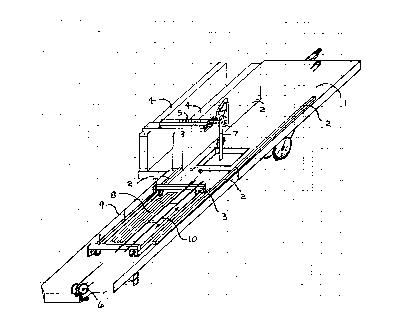Some of the information on this Web page has been provided by external sources. The Government of Canada is not responsible for the accuracy, reliability or currency of the information supplied by external sources. Users wishing to rely upon this information should consult directly with the source of the information. Content provided by external sources is not subject to official languages, privacy and accessibility requirements.
Any discrepancies in the text and image of the Claims and Abstract are due to differing posting times. Text of the Claims and Abstract are posted:
| (12) Patent: | (11) CA 2175606 |
|---|---|
| (54) English Title: | PORTABLE CHAINSAWMILL |
| (54) French Title: | SCIERIE A CHAINE PORTATIVE |
| Status: | Expired and beyond the Period of Reversal |
| (51) International Patent Classification (IPC): |
|
|---|---|
| (72) Inventors : |
|
| (73) Owners : |
|
| (71) Applicants : |
|
| (74) Agent: | |
| (74) Associate agent: | |
| (45) Issued: | 2000-10-03 |
| (22) Filed Date: | 1996-05-02 |
| (41) Open to Public Inspection: | 1997-11-03 |
| Examination requested: | 1996-09-06 |
| Availability of licence: | N/A |
| Dedicated to the Public: | N/A |
| (25) Language of filing: | English |
| Patent Cooperation Treaty (PCT): | No |
|---|
| (30) Application Priority Data: | None |
|---|
A portable chainsawmill that enables on site processing of
timber into dimension lumber ready for construction. The
cutting means is a stationary, vertically upright mounted
chainsaw with a special throttle control. The topside of
the sawbar rips the timber and propels the sawdust in a
downward direction. The sawmount is designed for sideways
positioning of the chainsaw between cuts. The sawmount
permits quick removal of the chainsaw for recharging of
resevoirs or maintenance. The timber conveyance is a
rolling trolley that operates on a flat deck. The trolley
is kept in line with allignment guides. The timber normally
rests on a mill table which is mounted on the trolley. The
timber is secured with a suitable means. The mill table has
slots in it which allow the sawbar nose to pass under the
timber and sawdust to pass. An auxilliary table on the
trolley permits slabs to be cut off of large logs when
necessary and also serves as a catchment or storage area
for lumber being processed. The trolley is pulled through
the sawbar with a winching apparatus. Sawdust is propelled
through an opening in the deck to a pile under the deck.
This complete chainsawmill is modular and very easy to
erect in remote locations.
Note: Claims are shown in the official language in which they were submitted.
Note: Descriptions are shown in the official language in which they were submitted.

2024-08-01:As part of the Next Generation Patents (NGP) transition, the Canadian Patents Database (CPD) now contains a more detailed Event History, which replicates the Event Log of our new back-office solution.
Please note that "Inactive:" events refers to events no longer in use in our new back-office solution.
For a clearer understanding of the status of the application/patent presented on this page, the site Disclaimer , as well as the definitions for Patent , Event History , Maintenance Fee and Payment History should be consulted.
| Description | Date |
|---|---|
| Time Limit for Reversal Expired | 2006-05-02 |
| Inactive: Adhoc Request Documented | 2006-02-06 |
| Inactive: Adhoc Request Documented | 2006-02-06 |
| Letter Sent | 2005-05-02 |
| Inactive: Office letter | 2004-07-27 |
| Change of Address Requirements Determined Compliant | 2004-06-23 |
| Inactive: Office letter | 2004-06-23 |
| Letter Sent | 2004-05-03 |
| Inactive: Single transfer | 2004-04-23 |
| Change of Address or Method of Correspondence Request Received | 2004-04-23 |
| Inactive: Adhoc Request Documented | 2004-03-29 |
| Grant by Issuance | 2000-10-03 |
| Inactive: Cover page published | 2000-10-02 |
| Pre-grant | 2000-07-04 |
| Inactive: Final fee received | 2000-07-04 |
| Notice of Allowance is Issued | 2000-02-28 |
| Letter Sent | 2000-02-28 |
| Notice of Allowance is Issued | 2000-02-28 |
| Inactive: Status info is complete as of Log entry date | 2000-02-24 |
| Inactive: Application prosecuted on TS as of Log entry date | 2000-02-24 |
| Inactive: Approved for allowance (AFA) | 1999-10-08 |
| Application Published (Open to Public Inspection) | 1997-11-03 |
| Request for Examination Requirements Determined Compliant | 1996-09-06 |
| All Requirements for Examination Determined Compliant | 1996-09-06 |
There is no abandonment history.
The last payment was received on 2000-03-31
Note : If the full payment has not been received on or before the date indicated, a further fee may be required which may be one of the following
Please refer to the CIPO Patent Fees web page to see all current fee amounts.
| Fee Type | Anniversary Year | Due Date | Paid Date |
|---|---|---|---|
| MF (application, 2nd anniv.) - small | 02 | 1998-05-04 | 1998-04-09 |
| MF (application, 3rd anniv.) - small | 03 | 1999-05-03 | 1999-04-23 |
| MF (application, 4th anniv.) - small | 04 | 2000-05-02 | 2000-03-31 |
| Final fee - small | 2000-07-04 | ||
| MF (patent, 5th anniv.) - small | 2001-05-02 | 2001-04-05 | |
| MF (patent, 6th anniv.) - small | 2002-05-02 | 2002-04-22 | |
| MF (patent, 7th anniv.) - small | 2003-05-02 | 2003-04-03 | |
| MF (patent, 8th anniv.) - small | 2004-05-03 | 2004-04-23 |
Note: Records showing the ownership history in alphabetical order.
| Current Owners on Record |
|---|
| ROBERT BURKHART |
| Past Owners on Record |
|---|
| None |